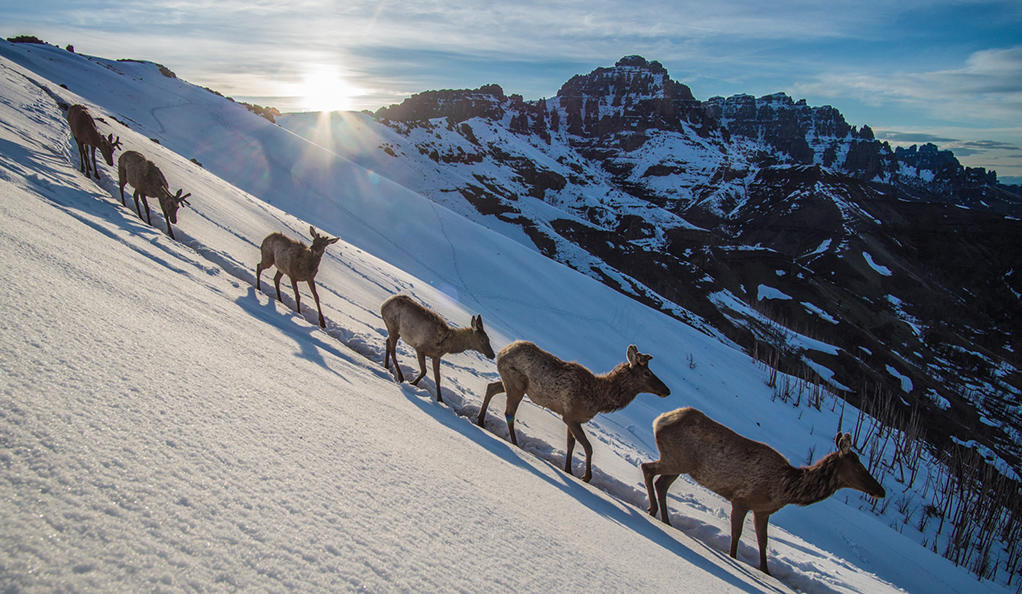“Invisible Boundaries,” an exhibition exploring the migrations of animals in and near Yellowstone Park, will open on Saturday, Sept. 16 at the Yale Peabody Museum of Natural History.
“Humans impose boundaries on landscapes that do not really exist in the eyes of the wild animals that live there,” write the exhibit organizers. “These ‘invisible boundaries’ include lines between national park and wilderness areas, public and private lands, and neighboring states and countries.”
The “Invisible Boundaries” exhibit is the result of a collaboration between two Yale alumni — ecologist Arthur Middleton ’07 Yale M.E.M. and artist and naturalist James Prosek ’97 B.A. — and photographer Joe Riis, and videographer Jenny Nichols, who spent several years exploring the meaning of these migrations as they occur in the Greater Yellowstone ecosystem, one of the world’s most renowned natural heritage sites.
Developed by the Buffalo Bill Center of the West, “Invisible Boundaries” presents the stories of elk and other wildlife of Yellowstone, exploring the challenges these animals face as they leave the Park and cross into surrounding multiple-use and private lands in search of winter resources. Their journeys link the ecosystem’s outermost foothills and ranchlands to its deepest, mountain wilderness.
Saturday is also “Invisible Boundaries” Family Day. Special activities from 10 a.m. to 3 p.m. will introduce concepts of animal migration and wildlife ecology through hands-on science and art activities. There will be a scavenger hunt, diorama and art stations. The exhibition and activities are free with museum admission. Children under age 3 are admitted for free.
“Invisible Boundaries” features large-scale photographs by Riis, 20 paintings by Prosek, an 8-minute film by Nichols, and interactive 3-D maps illustrating Yellowstone’s many migration routes. Together they document not only the animals’ migratory behavior and challenges but how dependent they are on the actions of landowners and other stakeholders far beyond national park borders.
Augmenting the traveling exhibition is a presentation exploring the creation of Yellowstone as the first national park, featuring objects from Yale’s Beinecke Rare Book & Manuscript Library. Civil War veteran and photographer William Henry Jackson’s 1871 “Views of the Yellowstone” documents both the landscape and the region’s Native American presence. Artist Thomas Moran’s 1871 watercolor “The Castle Geiser” is represented by a chromolithographic reproduction. Together with Jackson’s photographs, Moran’s work was key to Congress’s recognition of Yellowstone as a national park in 1872.
Walter Reagles’ “The Yellowstone,” displayed on a video monitor, is a pictorial diary of his 1904 trip to Yellowstone. His captioned watercolor and pen and ink drawings depict scenery, wildlife, and fellow visitors. A quote referencing Yellowstone by Rudyard Kipling appears on the first page. Edward Linton’s 1890 “Diary of an expedition through Yellowstone National Park” documents stream conditions, flow direction, and the fish he caught within the park’s waters. Frank R. Oastler’s 1933 photograph album documents Yellowstone wildlife. Carleton E. Watkins’ photographs feature themes of increasing tourism and the park’s natural wonders.
Partnering with the Buffalo Bill Center in developing “Invisible Boundaries” were the Yale School of Forestry & Environmental Studies, the Yale Institute for Biospheric Studies, University of Wyoming’s Wyoming Migration Initiative, and Split Rock Studios. The exhibition springs from a research grant awarded to Middleton and Riis through the 2013 Camp Monaco Prize under a partnership among the Prince Albert II of Monaco Foundation-USA, Buffalo Bill Center of the West’s Draper Natural History Museum, and University of Wyoming’s Biodiversity Institute.
Support for “Invisible Boundaries” at the Yale Peabody Museum was provided by the Yale Institute for Biospheric Studies. The exhibition will be on view through March 25.
Source: http://bit.ly/2xepcLP











